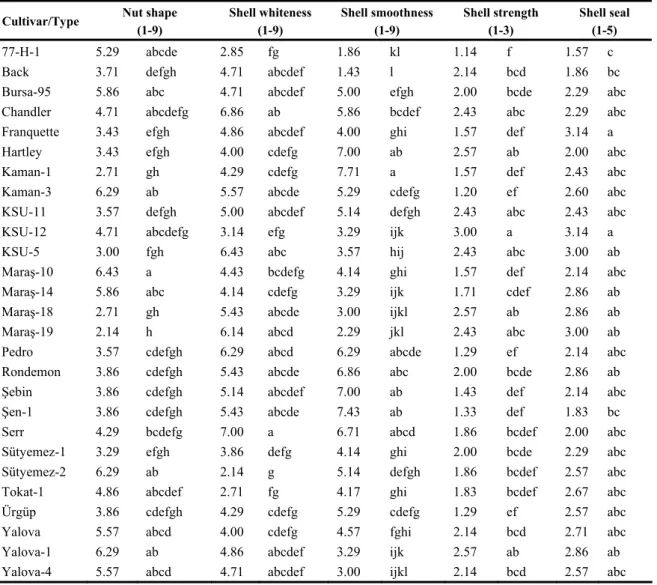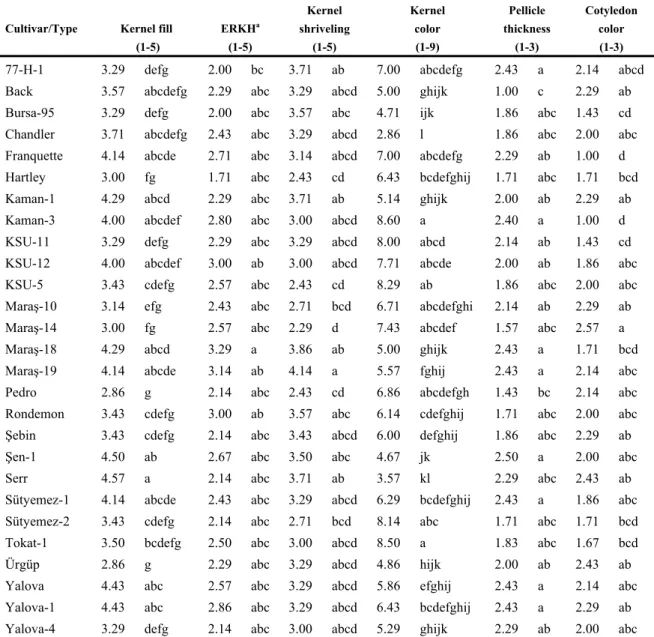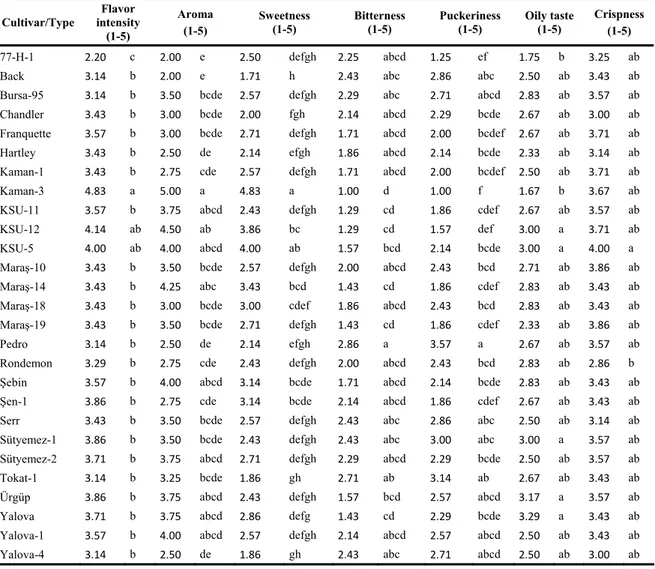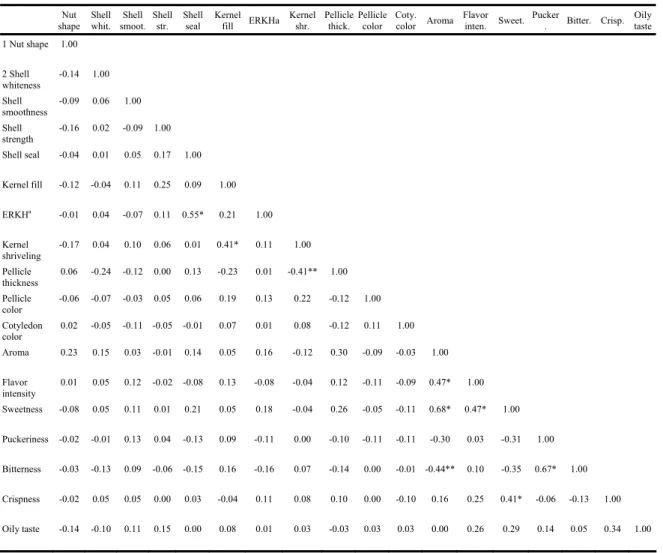Sensory and Descriptor Attributes of Some Walnut Cultivars and Types
Muharrem Ergun1*, Mehmet Sütyemez1 and Nazan Ergun11 Department of Horticulture, KSU, Kahramanmaraş, Turkey 2 Agricultural Research Institute, Kahramanmaraş, Turkey
ABSTRACT
The study presents an extensive assessment of sensory and descriptor attributes of 27 walnut (Juglans Regia L.) cultivars and types. Descriptive analyses were used for a total of 15 cultivars and 12 types, harvested from a collection walnut orchard located in city of Kahramanmaraş, Turkey, by a panel of 14 consisting of horticultural students and staff. The assessment enclosed three main descriptors, and sensory attributes which were nut structure, kernel structure, and flavor and texture. The nut shape of the cultivars/types was mainly rated broad to ovate. ‘Sütyemez-2’ and ’77-H-1’ types were recorded to have the whitest shell color whereas ‘Chandler’ cultivar was recorded to have the whitest kernel color. Most of the cultivars/types had a moderate kernel fill and shriveling score. The highest score of aroma, flavor and sweetness intensity was noted in ‘Kaman-3’ while bitterness, puckeriness and sweetness assessments greatly changing among cultivars/types. Crispness rating of the cultivars/types was almost the same, with the exception ‘KSU-5’being crispier than others.
Key Words: Junglas regia L., sensory evaluation, kernel, pellicle, cotyledon color.
INTRODUCTION
Sensory evaluation and product tasting have been in existence ever since human being started use his/her senses to judge the quality of food. Professional testing has been arisen with the development of trades, especially for tea, coffee and wine (Carpenter et al 2000). Every day, a new foodstuff is being marketed, consequently, the need for sensory evaluations for the product is growing. For a last few decades, raw horticultural crops have been included in sensory testing. The use sensory evaluation in fruits and vegetables has become a common application in order to qualify and quantify physiological and genetic variations. A few institutions, Unites Sate Department of Horticulture (USDA), International Union for Protection New Varieties of plants (UPOV) and International Plant Genetic Resources Institute (IPGRI), have taken responsibility for investigations on descriptive terminology for horticultural crops (Sinesio and Moneta 1997).
The most widely accepted and used descriptive terminology for walnut has been developed by IPGRI (1994). The descriptors for walnut were prepared by IPRGI illustrate the important traits of walnut germplasm. These traits contain descriptive characterization of the tree, leaf, nut and kernel, providing discrimination among phenotypes. This list does not adequately cover the traits related to taste and texture, thus the descriptive terms for walnut fruit taste and texture have not been standardized yet. Nonetheless, few studies have successfully applied the taste and texture attributes of walnut fruit for a sensory evaluation (Ingels et al 1990; Sinesio and Moneta 1997; Sinesio et al 2001).
Fruit breeding programs primarily focus yield, disease resistance, flowering habit, etc., however, sensory evaluation is usually left behind yield and tree traits, and walnut is not an exemption from this category. The early sensory evaluation reporting of walnut fruit started with brief statements, for example “good flavor”, “a mild, fairly sweet flavor” and “sweet kernel” (Serr and Forde 1956; Brooks and Olmo 1972). The first serious sensory evaluation study was done by Ingels and his coworkers (1990) on 8 cultivars, with reporting more detailed sensory descriptions, such as “astringency”, “walnut flavor”, “sweetness” and “firmness”. Later on, very detailed sensory evaluation studies on walnut fruit were carried out by Sinesio and Sinesios’ stuff (Sinesio and Moneta 1997; Sinesio et al 2001). Sinesio and Moneta (1997) observed 15 descriptive terms using 3 cultivars ‘Hartley’, ‘Franquette’ and ‘Serr’ collected from 5 different countries (France, Greece, Italy, Portugal and Spain). Sinesio et al (2001) increased the number of descriptive terms up to 32 using 4 cultivars ‘Hartley’, ‘Franquette’, ‘Sorrento’ and ‘Malizia’ from three different countries (Italy, France and Spain).
On these basis of the previous works done by Sinesio and his/her stuff, this work aimed to differentiate the sensory attributes of the selected walnut cultivars/types and to profile their sensory characteristics, with modifying some sensory attributes specified by Sinesio et al (2001).
MATERIALS AND METHODS
Material
A total of 15 walnut cultivars and 12 types were used in the present study. Fruit of the cultivars were harvested in 2007 when fully ripe and, gathered from 10 - 12-year old plants. The husks of the fruit were removed after harvest, then, sun-dried for a few days until the humidity level dropped around 12%. The nuts, afterwards, were stored at the room temperature and tested within 4 weeks.
Panel and testing procedure
The panel consisted of 14 members from undergraduate and graduate students, and faculties of the department of horticulture. Of these assessors, five had at least 2-year experience in sensory evolution. The panelists received preliminary training for a couple days before the testing. The preliminary training included sample tasting and discussion sessions on the definition and rating of each attribute. The sensory testing was done at the room temperature and under florescent light. During the testing, each assessor randomly received a set of 5 or more sample in a different order. The panelists were served a glass of rinsing water and salted biscuits between samples.
The descriptive terms were selected from the previous works done by Sinesio and his/her stuff (Sinesio and Moneta 1997; Sinesio et al 2001), and from the descriptors for walnut prepared by IPRGI (1994) (Table 1). The panelists were asked to rank the selected attributes on a descriptive graduated scale. The scales were either adopted from the descriptors for walnut (IPRGI 1994) and former studies (Sinesio and Moneta 1997; Sinesio et al 200) or developed by the stuff in the department of horticulture. These scores were given numerical values by the assessor. Five nut (shell shape, whiteness, smoothness, strength and seal), 6 kernel (kernel fill, ease of removal o kernel halves, kernel shrivel, kernel color, pellicle thickness and cotyledon color) and 6 flavor and texture attributes (flavor intensity, aroma, sweetness, bitterness, puckeriness, oily taste and crispness) were asked to rank by the panelist.
Table 1. Definitions of descriptors and sensory attributes assessed in this study
Nut structure
Nut shape -longitudinal and perpendicular to suture (1 = round, 2 = triangular, 3 = broad ovate, 4 = ovate, 5 =
short trapezoid, 6 = long trapezoid, 7 = broad elliptic, 8 = elliptic, 9 = cordate)
Shell whiteness -the relative degree of intensity of white color on the shell (1 = white, …, 9 = off-white)
Shell smoothness -shell texture, from smooth to rough (1 = very smooth, …, 9 = very rough)
Shell strength -shell firmness against hand pressure (1 = weak, 2 = intermediate, 3 = strong)
Shell seal -shell physical structure from open or very week to very strong (1= open or very week, 2 = week, 3
= intermediate, 4 = strong, 5 = very strong)
Kernel structure
Kernel fill - the relative degree of intensity of kernel size filling the shell space (1 = very poor, 2 = poor, 3 =
intermediate, 4 = well, 5 = very well) Ease of removal
of kernel halves
- the relative degree of intensity of ease when removing kernel halves (1 = very easy, 2 = easy, 3 = moderate, 4 = difficult, 5 = very difficult)
Kernel shriveling - the relative degree of intensity of kernel shriveling (1 = very shriveled, 2 = shriveled, 3 =
intermediate, 4 = swollen , 5 = very swollen)
Kernel color -white to yellow to brown color (1 = white, 2 = white/yellow, …, 9 = brown)
Pellicle thickness - the relative degree of intensity of thickness (1 = thin, 2 = intermediate, 3 = thick)
Cotyledon color -white to yellow color of the cotyledon ( 1 = white, 2 = white/yellow, 3 = yellow)
Flavor and texture
Flavor intensity - the relative degree of intensity of typical walnut flavor ( 1 = weak, …, 5 = very strong)
Aroma - the relative degree of intensity of typical walnut aroma ( 1 = weak, …, 5 = very strong)
Sweetness -the relative degree of or intensity of sweet sensation upon chewing ( 1 = weak, …, 5 = very strong)
Bitterness -the relative degree of or intensity of bitter sensation upon chewing ( 1 = weak, …, 5 = very strong)
Puckeriness -the relative degree of or intensity of puckery sensation upon chewing ( 1 = weak, …, 5 = very
strong)
Oily taste -the relative degree of or intensity of oily sensation upon chewing ( 1 = weak, …, 5 = very strong)
Crispness -force required to for the first bite plus the noise resulting from this bite (1 = very soft, …, 4 = crisp,
Statistical analyzed
Each panel was analyzed as a randomized complete block design with the assessors as block and cultivars/types as treatments. Data for all cultivars were analyzed using ANOVA in SAS. Means were compared using the Duncan test (P ≤ 0.05).
RESULTS AND DISCUSSION
The nut shape of the cultivars/and types was rated as triangular, broad ovate, ovate, short trapezoid, long trapezoid and broad elliptic (Table 2). Broad ovate and ovate were the most common shapes to describe for nuts while round, elliptic and cordate shape were never rated. Most of the cultivars/types showed a moderate degree of whiteness on the shell (Table 2). ‘Sütyemez-2’ and 77-H-1’ types and ‘Tokat-1’ cultivar had the whitest shell while ‘Serr’ cultivar the off-whitest. Shell surface structure measured as smoothness to roughness varied among cultivars/types while most of them were rated as having rough shell surface (Table 2). No cultivar/type showed a total smoothness on their nut surface. However, ‘Back’ cultivar had the smoothest nut surface among cultivars/types. Shell strength degree measured against hand pressure greatly differed among cultivars/types (Table 2). Nonetheless, only ‘KSU-12’ type had strong shell strength. Shell seal degree of the cultivars/types was quite constant for the nuts (weak or intermediate) (Table 2). However, ‘Back’, ‘Şen-1’ and ’77-H-1’ were rated as open to weak.
Table 2. Mean separations for nut structure
Cultivar/Type Nut shape
(1-9) Shell whiteness (1-9) Shell smoothness (1-9) Shell strength (1-3) Shell seal (1-5) 77-H-1 5.29 abcde 2.85 fg 1.86 kl 1.14 f 1.57 c
Back 3.71 defgh 4.71 abcdef 1.43 l 2.14 bcd 1.86 bc
Bursa-95 5.86 abc 4.71 abcdef 5.00 efgh 2.00 bcde 2.29 abc
Chandler 4.71 abcdefg 6.86 ab 5.86 bcdef 2.43 abc 2.29 abc
Franquette 3.43 efgh 4.86 abcdef 4.00 ghi 1.57 def 3.14 a
Hartley 3.43 efgh 4.00 cdefg 7.00 ab 2.57 ab 2.00 abc
Kaman-1 2.71 gh 4.29 cdefg 7.71 a 1.57 def 2.43 abc
Kaman-3 6.29 ab 5.57 abcde 5.29 cdefg 1.20 ef 2.60 abc
KSU-11 3.57 defgh 5.00 abcdef 5.14 defgh 2.43 abc 2.43 abc
KSU-12 4.71 abcdefg 3.14 efg 3.29 ijk 3.00 a 3.14 a
KSU-5 3.00 fgh 6.43 abc 3.57 hij 2.43 abc 3.00 ab
Maraş-10 6.43 a 4.43 bcdefg 4.14 ghi 1.57 def 2.14 abc
Maraş-14 5.86 abc 4.14 cdefg 3.29 ijk 1.71 cdef 2.86 ab
Maraş-18 2.71 gh 5.43 abcde 3.00 ijkl 2.57 ab 2.86 ab
Maraş-19 2.14 h 6.14 abcd 2.29 jkl 2.43 abc 3.00 ab
Pedro 3.57 cdefgh 6.29 abcd 6.29 abcde 1.29 ef 2.14 abc
Rondemon 3.86 cdefgh 5.43 abcde 6.86 abc 2.00 bcde 2.86 ab
Şebin 3.86 cdefgh 5.14 abcdef 7.00 ab 1.43 def 2.14 abc
Şen-1 3.86 cdefgh 5.43 abcde 7.43 ab 1.33 def 1.83 bc
Serr 4.29 bcdefg 7.00 a 6.71 abcd 1.86 bcdef 2.00 abc
Sütyemez-1 3.29 efgh 3.86 defg 4.14 ghi 2.00 bcde 2.29 abc
Sütyemez-2 6.29 ab 2.14 g 5.14 defgh 1.86 bcdef 2.57 abc
Tokat-1 4.86 abcdef 2.71 fg 4.17 ghi 1.83 bcdef 2.67 abc
Ürgüp 3.86 cdefgh 4.29 cdefg 5.29 cdefg 1.29 ef 2.57 abc
Yalova 5.57 abcd 4.00 cdefg 4.57 fghi 2.14 bcd 2.71 abc
Yalova-1 6.29 ab 4.86 abcdef 3.29 ijk 2.57 ab 2.86 ab
Kernels fill was moderately rated for the cultivars/types, with being exemption of ‘Pedro’ and ‘Ürgüp’ whose kernel fill degree changed from poor to intermediate (Table 3). No cultivar/types had a very difficult degree kernel removing (Table 3). ‘Hartley’ was chosen as the most ease-of-kernel-removal cultivar. Most of the cultivars/types had a moderate kernel shriveling while ‘Maraş-19’ had a swollen to very swollen kernel structure (Table 3). ‘Chandler’ had the whitest kernel color while rest of them white-yellow color (Table 3). ‘Back’ cultivar had the thinnest pellicle followed by ‘Pedro’; most of the cultivars/types had an intermediate-thick pellicle structure (Table 3). ‘Kaman-3’ and ‘Franquette’ cultivars had white cotyledon color whereas the rest of them white/yellow and yellow (Table 3). Kernel color of ‘Franquette’ was evaluated as lightest by Charlot et al (1996). Ten years later, in another sensory evaluation study, ‘Franquette’ was chosen to have the lightest shell and kernel color among 10 cultivars grown in Moribor, Slovenia (Colaric et al 2006).
Table 3. Mean separations for kernel structure Cultivar/Type Kernel fill
(1-5) ERKHa (1-5) Kernel shriveling (1-5) Kernel color (1-9) Pellicle thickness (1-3) Cotyledon color (1-3)
77-H-1 3.29 defg 2.00 bc 3.71 ab 7.00 abcdefg 2.43 a 2.14 abcd
Back 3.57 abcdefg 2.29 abc 3.29 abcd 5.00 ghijk 1.00 c 2.29 ab
Bursa-95 3.29 defg 2.00 abc 3.57 abc 4.71 ijk 1.86 abc 1.43 cd
Chandler 3.71 abcdefg 2.43 abc 3.29 abcd 2.86 l 1.86 abc 2.00 abc
Franquette 4.14 abcde 2.71 abc 3.14 abcd 7.00 abcdefg 2.29 ab 1.00 d
Hartley 3.00 fg 1.71 abc 2.43 cd 6.43 bcdefghij 1.71 abc 1.71 bcd
Kaman-1 4.29 abcd 2.29 abc 3.71 ab 5.14 ghijk 2.00 ab 2.29 ab
Kaman-3 4.00 abcdef 2.80 abc 3.00 abcd 8.60 a 2.40 a 1.00 d
KSU-11 3.29 defg 2.29 abc 3.29 abcd 8.00 abcd 2.14 ab 1.43 cd
KSU-12 4.00 abcdef 3.00 ab 3.00 abcd 7.71 abcde 2.00 ab 1.86 abc
KSU-5 3.43 cdefg 2.57 abc 2.43 cd 8.29 ab 1.86 abc 2.00 abc
Maraş-10 3.14 efg 2.43 abc 2.71 bcd 6.71 abcdefghi 2.14 ab 2.29 ab
Maraş-14 3.00 fg 2.57 abc 2.29 d 7.43 abcdef 1.57 abc 2.57 a
Maraş-18 4.29 abcd 3.29 a 3.86 ab 5.00 ghijk 2.43 a 1.71 bcd
Maraş-19 4.14 abcde 3.14 ab 4.14 a 5.57 fghij 2.43 a 2.14 abc
Pedro 2.86 g 2.14 abc 2.43 cd 6.86 abcdefgh 1.43 bc 2.14 abc
Rondemon 3.43 cdefg 3.00 ab 3.57 abc 6.14 cdefghij 1.71 abc 2.00 abc
Şebin 3.43 cdefg 2.14 abc 3.43 abcd 6.00 defghij 1.86 abc 2.29 ab
Şen-1 4.50 ab 2.67 abc 3.50 abc 4.67 jk 2.50 a 2.00 abc
Serr 4.57 a 2.14 abc 3.71 ab 3.57 kl 2.29 abc 2.43 ab
Sütyemez-1 4.14 abcde 2.43 abc 3.29 abcd 6.29 bcdefghij 2.43 a 1.86 abc
Sütyemez-2 3.43 cdefg 2.14 abc 2.71 bcd 8.14 abc 1.71 abc 1.71 bcd
Tokat-1 3.50 bcdefg 2.50 abc 3.00 abcd 8.50 a 1.83 abc 1.67 bcd
Ürgüp 2.86 g 2.29 abc 3.29 abcd 4.86 hijk 2.00 ab 2.43 ab
Yalova 4.43 abc 2.57 abc 3.29 abcd 5.86 efghij 2.43 a 2.14 abc
Yalova-1 4.43 abc 2.86 abc 3.29 abcd 6.43 bcdefghij 2.43 a 2.29 ab
Yalova-4 3.29 defg 2.14 abc 3.00 abcd 5.29 ghijk 2.29 ab 2.00 abc
a Ease of removal of kernel
Aroma and flavor intensity showed almost same pattern, with ‘Kaman-3’ having the strongest taste and aroma while ’77-H-1’ the weakest (Table 4). Sweetness intensity was mostly rated moderate for cultivars/types (Table 4). ‘Kaman-3’ had a very strong sweet flavor taste. Most of the cultivars/types had a very minor degree of bitterness (Table 4). ‘Kaman-3’ had the lowest degree of bitterness while ‘Pedro’
highest. Puckeriness was stronger only in ‘Tokat-1’ and ‘Pedro’ cultivars; the rest of the cultivars/types had slight degree of puckeriness (Table 4). ‘Yalova’ and ‘Ürgüp’ had the strongest oily taste flavor while ’77-H-1’ type and ‘Kaman-3’ the weakest (Table 4). Crispness of the cultivars/types was almost the same; ‘KSU-5’ was crisper than others while ‘Rondemon’ softer than others (Table 4).
Table 4. Mean separation for flavor and texture attributes Cultivar/Type Flavor intensity (1-5) Aroma (1-5) Sweetness (1-5) Bitterness (1-5) Puckeriness (1-5) Oily taste (1-5) Crispness (1-5) 77-H-1 2.20 c 2.00 e 2.50 defgh 2.25 abcd 1.25 ef 1.75 b 3.25 ab Back 3.14 b 2.00 e 1.71 h 2.43 abc 2.86 abc 2.50 ab 3.43 ab Bursa-95 3.14 b 3.50 bcde 2.57 defgh 2.29 abc 2.71 abcd 2.83 ab 3.57 ab Chandler 3.43 b 3.00 bcde 2.00 fgh 2.14 abcd 2.29 bcde 2.67 ab 3.00 ab Franquette 3.57 b 3.00 bcde 2.71 defgh 1.71 abcd 2.00 bcdef 2.67 ab 3.71 ab Hartley 3.43 b 2.50 de 2.14 efgh 1.86 abcd 2.14 bcde 2.33 ab 3.14 ab Kaman-1 3.43 b 2.75 cde 2.57 defgh 1.71 abcd 2.00 bcdef 2.50 ab 3.71 ab Kaman-3 4.83 a 5.00 a 4.83 a 1.00 d 1.00 f 1.67 b 3.67 ab KSU-11 3.57 b 3.75 abcd 2.43 defgh 1.29 cd 1.86 cdef 2.67 ab 3.57 ab KSU-12 4.14 ab 4.50 ab 3.86 bc 1.29 cd 1.57 def 3.00 a 3.71 ab KSU-5 4.00 ab 4.00 abcd 4.00 ab 1.57 bcd 2.14 bcde 3.00 a 4.00 a Maraş-10 3.43 b 3.50 bcde 2.57 defgh 2.00 abcd 2.43 bcd 2.71 ab 3.86 ab Maraş-14 3.43 b 4.25 abc 3.43 bcd 1.43 cd 1.86 cdef 2.83 ab 3.43 ab Maraş-18 3.43 b 3.00 bcde 3.00 cdef 1.86 abcd 2.43 bcd 2.83 ab 3.43 ab Maraş-19 3.43 b 3.50 bcde 2.71 defgh 1.43 cd 1.86 cdef 2.33 ab 3.86 ab Pedro 3.14 b 2.50 de 2.14 efgh 2.86 a 3.57 a 2.67 ab 3.57 ab Rondemon 3.29 b 2.75 cde 2.43 defgh 2.00 abcd 2.43 bcd 2.83 ab 2.86 b Şebin 3.57 b 4.00 abcd 3.14 bcde 1.71 abcd 2.14 bcde 2.83 ab 3.43 ab Şen-1 3.86 b 2.75 cde 3.14 bcde 2.14 abcd 1.86 cdef 2.67 ab 3.43 ab Serr 3.43 b 3.50 bcde 2.57 defgh 2.43 abc 2.86 abc 2.50 ab 3.14 ab Sütyemez-1 3.86 b 3.50 bcde 2.43 defgh 2.43 abc 3.00 abc 3.00 a 3.57 ab Sütyemez-2 3.71 b 3.75 abcd 2.71 defgh 2.29 abcd 2.29 bcde 2.50 ab 3.57 ab Tokat-1 3.14 b 3.25 bcde 1.86 gh 2.71 ab 3.14 ab 2.67 ab 3.43 ab Ürgüp 3.86 b 3.75 abcd 2.43 defgh 1.57 bcd 2.57 abcd 3.17 a 3.57 ab Yalova 3.71 b 3.75 abcd 2.86 defg 1.43 cd 2.29 bcde 3.29 a 3.43 ab Yalova-1 3.57 b 4.00 abcd 2.57 defgh 2.14 abcd 2.57 abcd 2.50 ab 3.43 ab Yalova-4 3.14 b 2.50 de 1.86 gh 2.43 abc 2.71 abcd 2.50 ab 3.00 ab
Among sensory and descriptor attributes, several characteristics showed a correlation which is displayed in Table 5. Ease of removal of kernel halves and shell seal appeared to be positively correlated. A more strong positive correlation was observed between sweetness and aroma or bitterness and puckeriness; and a weaker correlation between kernel shriveling and kernel fill, flavor intensity and aroma, sweetness and flavor intensity or crispness and sweetness. Pellicle thickness and shriveling or bitterness and aroma were however negatively but weakly correlated.
Both Sinesio and Moneta (1997) and Colaric et al (2006) reported that bitterness and puckeriness were positively correlated; we noted such an observation in our experiment. Booth bitterness and puckeriness are very important sensory properties of walnut fruit. Peleg et al (1999) stated that as molecular size of volatile compounds increases, bitterness decreases and puckeriness increases.
CONCLUSION
Both students and horticultural stuff similarly evaluated sensory and descriptor attributes of the walnut cultivars/types. In regards to nut shape, ‘Maraş-19’, ‘Sütyemez-1’ and ‘Yalova-4’ were the most preferable types among the cultivars/types while in regards to flavor and texture, ‘Kaman-3’ was favored. Based on this study, it can be suggested that consumer preferences should be considered for selection purpose of walnut
types before the final decision made. This in-dept investigation of both sensory and descriptor attributes can be easily used to evaluate for walnut nuts in future studies.
Table 5. Correlation matrix for all the sensory and descriptor attributes Nut
shape Shell whit. smoot.Shell Shell str. Shell seal Kernel fill ERKHa Kernel shr. Pellicle thick. Pellicle color Coty. color Aroma Flavor inten. Sweet. Pucker. Bitter. Crisp. Oily taste
1 Nut shape 1.00 2 Shell whiteness -0.14 1.00 Shell smoothness -0.09 0.06 1.00 Shell strength -0.16 0.02 -0.09 1.00 Shell seal -0.04 0.01 0.05 0.17 1.00 Kernel fill -0.12 -0.04 0.11 0.25 0.09 1.00 ERKHa -0.01 0.04 -0.07 0.11 0.55* 0.21 1.00 Kernel shriveling -0.17 0.04 0.10 0.06 0.01 0.41* 0.11 1.00 Pellicle thickness 0.06 -0.24 -0.12 0.00 0.13 -0.23 0.01 -0.41** 1.00 Pellicle color -0.06 -0.07 -0.03 0.05 0.06 0.19 0.13 0.22 -0.12 1.00 Cotyledon color 0.02 -0.05 -0.11 -0.05 -0.01 0.07 0.01 0.08 -0.12 0.11 1.00 Aroma 0.23 0.15 0.03 -0.01 0.14 0.05 0.16 -0.12 0.30 -0.09 -0.03 1.00 Flavor intensity 0.01 0.05 0.12 -0.02 -0.08 0.13 -0.08 -0.04 0.12 -0.11 -0.09 0.47* 1.00 Sweetness -0.08 0.05 0.11 0.01 0.21 0.05 0.18 -0.04 0.26 -0.05 -0.11 0.68* 0.47* 1.00 Puckeriness -0.02 -0.01 0.13 0.04 -0.13 0.09 -0.11 0.00 -0.10 -0.11 -0.11 -0.30 0.03 -0.31 1.00 Bitterness -0.03 -0.13 0.09 -0.06 -0.15 0.16 -0.16 0.07 -0.14 0.00 -0.01 -0.44** 0.10 -0.35 0.67* 1.00 Crispness -0.02 0.05 0.05 0.00 0.03 -0.04 0.11 0.08 0.10 0.00 -0.10 0.16 0.25 0.41* -0.06 -0.13 1.00 Oily taste -0.14 -0.10 0.11 0.15 0.00 0.08 0.01 0.03 -0.03 0.03 0.03 0.00 0.26 0.29 0.14 0.05 0.34 1.00 a: Ease of removal of kernel halves, *: Positive correlation, **: Negative correlation
REFERENCES
Brooks RM, and Olmo HP (1972). Register of new fruit and nut varieties. Second edition, Univ. of California Press, Berkley, USA. Carpenter RP, Lyon DH, and Hasdel TA (2000). Guidelines for sensory analysis in product development and quality control. Aspen
Publishers, Inc., Gaithersburg, Maryland, USA.
Charlot G, Prunet JP, Lagrue C, and Aleta N (1996). Noix et cerneaux – qualite et consummation. Centre technique interprofessional des fruits et legumes, Paris, France.
Colaric M, Stampar F, Hudina M, and Solar A (2006). Sensory evaluation of different walnut cultivars (Junglas regia L). Acta Agri Slovenia 87(2): 403-413.
Ingels CA, McGranahan GH, and Noble AC (1990). Sensory evaluation of selected Persian walnut cultivars. HortSci 25:1446-1447. IPRGI 1994. Descriptors for walnuts (Junglas ssp.). International Plant Genetic Resources Institute, Rome, Italy.
Peleg H, Gacon K, Schlich P, and Noble AC (1999). Bitterness and astringency of flavan-3-ol monomers, dimmers and trimers. J Sci Food Agr 79: 1123-1128.
Serr EF, and Forde HI (1956). Walnut breeding. Proc Amer Soc Hort Sci 68:184-194. Sinesio F, and Moneta E (1997). Sensory evaluation of walnut fruit. Food Qual Prefer 8:35-43.
Sinesio F, Guerrero L, Romero A, Moneta E, and Lombard JC (2001). Sensory evaluation of walnut: An interlaboratory study. Food Sci Technol Int 7: 37-47.



